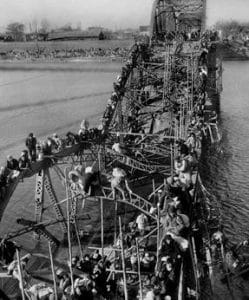In 1933, Desfor got a job with the Associated Press as a messenger — and darkroom assistant: his brother also worked for AP, doing touch-ups on news photos. By 1938, he was a staff photographer for the wire service. On December 7, 1941, Desfor, stationed in Washington D.C., learned that the Japanese had bombed Pearl Harbor, and he was sent to the State Department to see what he could find out. “Secretary of State Cordell Hull was berating two Japanese envoys sent to talk peace,” he remembered. “He was really yelling at them.” Then he got the idea to go to the Japanese Embassy, where diplomats were burning documents. “One guy with a broom was chasing photographers,” he said. “When they ran, we took pictures. When he chased us, the others took pictures.” He tried to join the U.S. Navy, but it wouldn’t accept his enlistment: he was the sole breadwinner for his family. But he went to war anyway as a correspondent, assigned to the staff of Admiral Chester W. Nimitz’s Pacific fleet. Among other things, he photographed Japan’s official surrender aboard the USS Missouri on September 2, 1945.

But Desfor is best known for a particular photo he took during the Korean War, which he also volunteered to cover. While riding in a Jeep near Pyongyang, he came across a bridge over the Taedong River that had been destroyed by U.S. bombers. That had unfortunately trapped Korean civilians trying to flee advancing Chinese forces. “We came across this incredible sight,” he said in an oral history. “All of these people who are literally crawling through these broken-down girders of the bridge. They were in and out of it, on top, underneath, and just barely escaping the freezing water.” But they were taking their turns, not rushing each other — and there were thousands of people. Desfor climbed into the girders himself, going up 50 feet to capture the scene. “My hands got so cold I could barely trip the shutter on my camera,” he said. “I couldn’t even finish a full pack of film. It was just that cold.” But that wasn’t the photo that Desfor found the most memorable. That was when he was in a field and noticed two frozen hands, bound together, sticking out of the snow: civilians who had been taken out and shot, and left to the weather. “I labeled that picture, later on, ‘Futility,’ because it’s always been— I’ve always felt that it’s the civilians caught in the crossfire, the civilians, the innocent civilians, how futile it is for war,” he said in the oral history. “That epitomized it to me.”
Since it was hard to choose just one photo, the AP put together a package of more than 50 of Desfor’s Korean War photos and submitted it for a Pulitzer Prize. The Pulitzer jury said the portfolio demonstrated “all the qualities which make for distinguished news photography — imagination, disregard for personal safety, perception of human interest and the ability to make the camera tell the whole story,” and he won the 1951 Pulitzer. Desfor retired from AP in 1978, spent five more years as the photo director for U.S. News & World Report, and then retired for good. His wife died in 1994, and in 2012 he married again — at 98 years old. He outlived her, too: she died in 2015, at 93. Desfor died at his home in Silver Spring, Md., on February 19 after suffering several strokes. He was 104.
